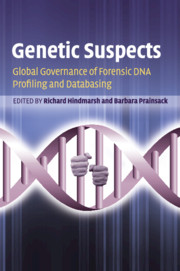Book contents
- Frontmatter
- Contents
- List of contributors
- About the contributors
- Foreword
- Acknowledgements
- 1 Introducing Genetic Suspects
- Section 1 Key areas in DNA profiling and databasing
- 2 Key issues in DNA profiling and databasing: implications for governance
- 3 Forensic utilization of voluntarily collected DNA samples: law enforcement versus human rights
- 4 Base assumptions? Racial aspects of US DNA forensics
- 5 Health and wealth, law and order: banking DNA against disease and crime
- 6 DNA profiling versus fingerprint evidence: more of the same?
- Section 2 National contexts of forensic DNA technologies and key issues
- Section 3 Conclusions
- Index
- References
6 - DNA profiling versus fingerprint evidence: more of the same?
from Section 1 - Key areas in DNA profiling and databasing
Published online by Cambridge University Press: 05 October 2012
- Frontmatter
- Contents
- List of contributors
- About the contributors
- Foreword
- Acknowledgements
- 1 Introducing Genetic Suspects
- Section 1 Key areas in DNA profiling and databasing
- 2 Key issues in DNA profiling and databasing: implications for governance
- 3 Forensic utilization of voluntarily collected DNA samples: law enforcement versus human rights
- 4 Base assumptions? Racial aspects of US DNA forensics
- 5 Health and wealth, law and order: banking DNA against disease and crime
- 6 DNA profiling versus fingerprint evidence: more of the same?
- Section 2 National contexts of forensic DNA technologies and key issues
- Section 3 Conclusions
- Index
- References
Summary
INTRODUCTION
While other chapters in this book address the role of national political cultures in the governance of DNA databases, in this chapter we examine how other forensic systems have provided models for the organisation of such databases. We will argue that many, but by no means all, aspects of DNA profiling followed patterns established historically by earlier techniques. In particular, we focus on fingerprint identification, the technique we view as most closely analogous to DNA profiling on several levels. Both fingerprinting and DNA profiling seek to identify particular bodies as sources of crime scene traces by examining correspondences between those traces and reference samples taken from persons in police custody. Both techniques proved useful enough from a social control perspective to warrant large government investments in developing databases of records indexed according to bodily markers. Finally, both fingerprinting and DNA profiling have enjoyed primacy as ‘gold standards’ in an imagined hierarchy of forensic techniques. Indeed, even today when DNA profiling is sometimes viewed as having supplanted fingerprinting, one recent report has noted that, ‘the more humble fingerprint retains its status as the most commonly used method of identification and is a cornerstone of forensic crime scene investigation’ (Nuffield Council on Bioethics 2007: 15).
Profiling with DNA is widely heralded as a novel and distinctively scientific technique for analysing criminal evidence that is having revolutionary impact on criminal justice systems throughout the world.
- Type
- Chapter
- Information
- Genetic SuspectsGlobal Governance of Forensic DNA Profiling and Databasing, pp. 105 - 128Publisher: Cambridge University PressPrint publication year: 2010
References
- 2
- Cited by



